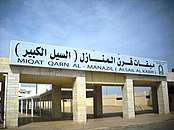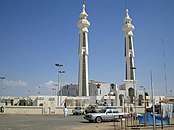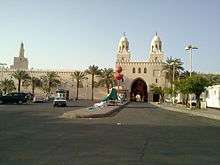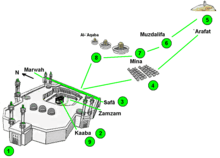Miqat
The miqat[1] (Arabic: مِيْقَات, romanized: mīqāt, lit. 'a stated place') is the principal boundary at which Muslim pilgrims intending to perform the Ḥajj or Umrah pilgrimages must be enter the state of iḥrām (lit. 'prohibition'), a state of consecration in which certain permitted activities are made prohibited.
| Miqat Qarn al-Manazil Miqat Yalamlam Miqat Dhat 'Irq Miqat al-Juhfah Miqat Dhu al-Hulayfah | |
|---|---|
ميقات قرن المنازل ميقات يلملم ميقات ذات عرق ميقات الجحفة ميقات ذو الحليفة | |
   Clockwise from top left: Miqat Qarn al-Manazil, Miqat Yalamlam, Miqat Dhu al-Hulayfah, Miqat al-Juhfah | |
| Religion | |
| Affiliation | Islam |
| Province | Dhu al-Hulayfah: Madinah Province Others: Makkah Province |
| Rite | Ihram |
| Location | |
| Country | |
| Website | |
| https://www.hajinformation.com/main/e101.htm | |
There are five miqats, four defined by the final Islamic prophet, Muhammad, and one by the second Rashidun caliph, 'Umar, to fulfill the needs of those offering the pilgrimages from the newly annexed regions in Mesopotamia.
List
The miqats are, sorted by ascending distance to Mecca, as follows:[2]
| Name | Location | Distance from Mecca | Defined by | Serves pilgrims arriving from |
|---|---|---|---|---|
| Qarn al-Manāzil | As-Sayl al-Kabir | 82 kilometres (51 mi) NE | Muhammad | Najd |
| Yalamlam (Arabic: يَلَمْلَم)[3] | Road 4347 (20°31′4.3″N 39°52′12.8″E), near Ash-Shafa | 105 kilometres (65 mi) SE | Yemen | |
| Dhāt 'Irq | Road 4281
near as-Sayl al-Kabir |
110 kilometres (68 mi) NE | Umar | Iran and Iraq |
| Al-Juhfah | Rabigh | 179 kilometres (111 mi) NW | Muhammad | Ash-Shām (Syria, Palestine, Jordan, etc.) |
| Dhu al-Hulayfah | Masjid ash-Shajarah | 424 kilometres (263 mi) N | Medina | |
| Masjid 'Aisha | Mecca | 6 kilometres (3.7 mi) NW | Mecca |
If a pilgrim intends to perform an additional 'Umrah, then ihram must be assumed outside the boundary of the Haram area before re-entering Mecca to carry out the rites of 'Umrah. Many pilgrims choose to enter into the state of ihram at Masjid 'Aisha, which is the nearest and most convenient location from Al-Masjid Al-Haram. The condition to perform 'Umrah from this miqat is that one should be a resident of Mecca, and/or have entered into Mecca for more than 15 days. Transportation to get to this location is readily available near the mosque. Additional 'Umrah, if a person so intends, can also be done by assuming Ihram at any of the five main miqats.[2]
Mīqāt Yalamlam (Arabic: مِيْقَات يَلَمْلَم) is the assigned Miqat for all pilgrims coming from all regions located to the south of Mecca, particularly Yemen. Miqat Yalamlam is nowadays a small souq with a mosque in the Province of Mecca. It is situated around 100 kilometres (62 mi) southwest of Mecca, and 90 kilometres (56 mi) north of Al Lith. Miqat Yalamlam is historically is the sole of Wadi Yalamlam. The current location is assigned by the Saudi government to be near the Red Sea coastal road (National Road No. 5), at a location called Saʿyā (سَعْيَا).[3]
Scholarly opinion on entering ihram in the air
Islamic scholarly opinion on how to enter ihram while flying in for the Hajj or Umrah slightly differs between ulama. Most interpret the hadith in Sahih Bukhari, Book 25, Hadith 14, which was narrated by Ibn 'Abbas:[4]
"Allah's Messenger (ﷺ) had fixed Dhul Hulaifa as the Miqat for the people of Medina; Al-Juhfa for the people of Sham; and Qarn Ul-Manazil for the people of Najd; and Yalamlam for the people of Yemen. So, these (above mentioned) are the Mawaqit for all those living at those places, and besides them for those who come through those places with the intention of performing Hajj and `Umra [sic] and whoever lives within these places should assume Ihram from his dwelling place, and similarly the people of Mecca can assume lhram from Mecca"
as meaning it is necessary to wear and assume ihram when leaving one's home. Others see wearing one's ihram before one's plane enters the miqat zone to be permissible too. A line drawn from the southernmost miqat at Yalamlam to the northwestern miqat at Juhfah puts Jeddah in the zone. Conventionally, pilots carrying pilgrims announce entering the miqat about 30 minutes prior, so that pilgrims can go to the lavatory and change.[2]
Al-Ḥaram
The Haram is the sacred precinct of Mecca within which certain acts are considered unlawful which may be lawful elsewhere. It is prohibited to hunt wild animals, damage any plant or tree, graze animals, carry weapons, fight, or behave in a manner that will violate the sanctity of Al-Masjid Al-Ḥarām. If a violation is carried out within the precinct of the Haram, an animal sacrifice (Arabic: دَمّ, romanized: damm) or gift of charity (ṣadaqah) is required as expiation. The boundaries of the Haram are the following:[2]
1. Masjid ʿĀʾishah (مَسْجِد عَائِشَة), also known as Masjid at-Tanʿīm (مَسْجِد ٱلْتَّنْعِيْم), located about 8 kilometres (5.0 mi) from the Kaaba and 5 kilometres (3.1 mi) away from Mecca, in the direction of Madinah.
2. Aḍāt Laban (أَضَاة لَبَن) or Aḍāt Libn (أَضَاة لِبْن) – On the road to Yemen, 11 kilometres (6.8 mi) away from Mecca.
3. Wādī Nakhlah – On the road to Iraq, 11 kilometres (6.8 mi) away from Mecca.
4. 'Arafat – On the road to Ta'if, close to Masjid al-Namirah in Arafat, 11 kilometres (6.8 mi) away from Makkah.
5. Masjid al-Jiʿrānah (مَسْجِد ٱلْجِعْرَانَة), located about 14 kilometres (8.7 mi) away from Mecca.
6. Masjid al-Ḥudaibiyah (مَسْجِد ٱلْحُدَيْبِيَة), on the road to Jeddah, about 16 kilometres (9.9 mi) away from Makkah.
See also
References
- Hughes, Thomas Patrick (1994). Dictionary of Islam. Chicago, IL, the USA: Kazi Publications Inc. USA. ISBN 0-935782-70-2.
- "Meeqath | Hajj & Umrah Planner". Hajjumrahplanner.com. Retrieved 2017-04-10.
- "Yalamlam | Hajj & Umrah Planner". hajjumrahplanner.com. Retrieved 2017-04-10.
- "Hadith - Book of Hajj (Pilgrimage) - Sahih al-Bukhari - Sunnah.com - Sayings and Teachings of Prophet Muhammad (صلى الله عليه و سلم)". sunnah.com. Retrieved 2020-08-08.
